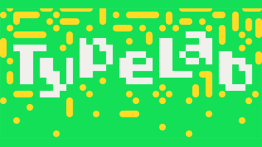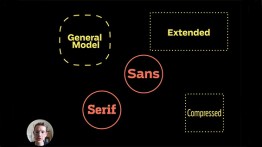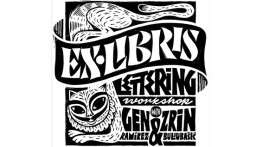Virtual TypeLab Draws Huge International Audience
POSTED ON: July 12, 2020
TypeLab, the hands-on workshop section of the annual Typographics festival, moved into a virtual space for this year’s conference with spectacular results. Running continuously for 72 hours, the lab crossed boundaries of space and time so that designers and typographers from around the world could take part in an extraordinary array of workshops. This year TypeLab ran from June 18–20, a little more than a month before the Typographics online conference, from July 24–26; the virtual book fair goes from July 22–26.
“Once we knew we weren’t going to be able to host Typographics on campus, it seemed TypeLab was the easiest part of the festival to go online, said Cara Di Edwardo, director of Cooper’s typography programs and one of the founders of the conference. “The hosts have always been digitally nimble and able to learn new technology, so Zoom and livestreaming seemed like easy things to take on.”
It’s clear from the numbers of people who took part in the workshops that they too found the switch to online platforms an easy transition to make: TypeLab rarely hosted more than 40 people at one time due to physical constraints. This year, more than 2,300 attendees signed in for Zoom calls, and approximately 5,500 more simply tuned into the livestream. “Historically type conferences would range from having 100 to about 1,200 attendees. Having 8,000 viewers for what has been a side event for a conference, was extraordinary,” Di Edwardo said.
The round-the-clock nature of the event was made possible by 20 volunteers and three sets of teams around the world, with designers in home bases in Mexico, India, and the Netherlands acting as hosts in different time zones. Most of the presentations ran for a half hour and covered a huge range of subjects in multiple languages. Speakers, more than 100 presenters in total, discussed topics like: what it takes to bring a font to production; using PageBot coding; the origin of Japanese kana characters; troubleshooting problems that occur using Chinese fonts with some apps; the fonts of an ancient type foundry in Bangalore; letters in cities as social artifacts; making audiovisual text animations; and dozens more.
TypeLab existed long before the Typographics conference. It had been co-founded by typeface designer and educator Petr van Blokland, among others, intended as a conference-within-a-conference for those more interested in swapping information one-on-one than listening to lectures. It had been part of other international conferences before settling at Typographics, which began in 2015. Di Edwardo recalls that that year “TypeLab took over the old St. Mark’s Bookstore space and with folding tables and a pop up projection screen the nerdiest of the type nerds gathered to show each other coding tricks and the latest font development tools as well and give each other feedback on projects and mini-workshops. It’s always been very spontaneous with a fluid changing schedule of events. A kind of typography hackathon.”
The Cooper Union’s digital art director, Mark Rossi, who has long been involved in guiding the conference’s design process, said he wasn’t surprised that the migration to an online platform was such a success. “It has a lot of advantages, especially since the audience for type design is an international one.” Working on the program this year, he noted that the Typographics conference needed to adjust its economic model: while in past years, participants paid for tickets for a seat in the physical space of the Great Hall, now the conference is completely online and free, the cost fully covered by sponsorship.
He added, “Historically most of the money made has been in the paid Typographics workshops [nb: this does not include TypeLab] and that is still the case in the digital environment. In addition, some of the sponsors and/or type designers have designed T-shirts with their typefaces that act as a promotion and all the profits help pay for the conference as well.”
In some ways the online platform was a natural fit for typographers and type designers, who very frequently use digital technology to make work that is used on digital platforms. Taking that to its logical extension, the firm Occupant Fonts gave a workshop showing how the task of kerning—balancing the space between letters or characters—could be greatly enhanced using machine learning. Members of Sandoll, a Korean type foundry, spoke about the ways they adapt Chinese, Japanese, Korean and Latin fonts to work side by side in the same environment as a “type family.” Joost Overbeek spoke in Dutch about an inclusive design agency in the Netherlands called Alleburen that employs designers with disabilities. Simon Charwey, a Ghanaian typographer, spoke about his projects using the Adinkra symbols of West Africa. One of the two workshops led by Gen Ramirez and Zrinka Buljubašić taught participants woodcut-style lettering for ex-libri, labels usually placed on inside book covers, that resulted in inspired designs by participants.
“The idea was to work with them in figuring out how to combine type and illustration with constraints of the wrapping shape,” said Ms. Buljubašić. “With this in mind, participants were playing with manipulation of space - specifically black and white, composition, proportion and balance of shapes and countershapes, and transmitting certain idea through specific style of letters and illustration.”
One of the remarkable outcomes of the online version of TypeLab was the explosion of workshops for typefaces in non-Roman scripts. “I think designers have always found writing systems other than their native scripts fascinating,” said Di Edwardo. There is something universally appealing about the shape of language especially when it’s crafted by experts who are in tune with the cultural and aesthetic qualities that visual language imparts.”
While the conference has always featured international guests who spoke about working with multiple scripts, this year TypeLab included many more participants teaching or learning about a wide variety of script systems, including Arabic, Indic scripts like Devanagari and Tamil, Thai, a little known script called Nüshu from a remote region of China, as well as CJK—collective characters common to Chinese, Japanese, and Korean.
"TypeLab's success proves that there is an incredible audience worldwide that wants to come together in unprecedented ways," said Alexander Tochilovsky, one of the conference organizers and director of the Herb Lubalin Study Center of Design and Typography. "An event like this gives a platform to a wealth of design being made across the world. The shifting of focus away from the traditional culture centers will go a long way to widen the lens of what's considered 'good' design and give a chance for more designers to be recognized."







